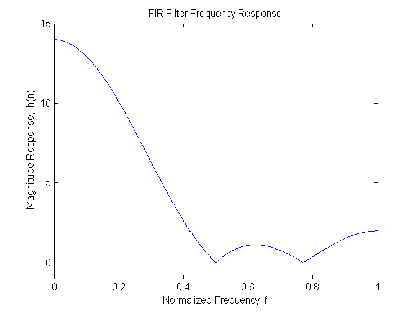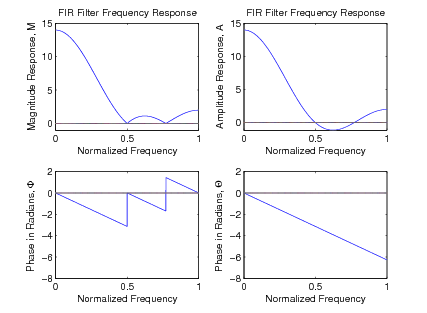Chapter 2. Finite Impulse Response Digital Filters and Their Design
2.1. FIR Digital Filters*
There are two types of linear, time-invariant digital filters. We will
investigate digital filters with a finite-duration impulse response
(FIR) in this section and those with an infinite-duration impulse
response (IIR) in another document. FIR filters have characteristics
that make them useful in many applications 3, 2.
FIR filters can achieve an exactly linear phase frequency response
FIR filters cannot be unstable.
FIR filters are generally less
sensitive to coefficient round-off and finite-precision arithmetic than
IIR filters.
FIR filters design methods are generally linear.
FIR filters can be efficiently realized on general or special-purpose
hardware.
However, frequency responses that need a rapid transition
between bands and do not require linear phase are often more efficiently
realized with IIR filters.
It is the purpose of this section to examine and
evaluate these characteristics which are important in the design
of the four basic types of linear-phase FIR filters.
Because of the usual methods of implementation, the Finite Impulse
Response (FIR) filter is also called a nonrecursive filter or
a convolution filter. From the time-domain view of this operation,
the FIR filter is sometimes called a moving-average or running-average filter. All of these names represent useful
interpretations that are discussed in this section; however, the
name, FIR, is most commonly seen in filter-design literature and is
used in these notes.
The duration or sequence length of the impulse response of
these filters is by definition finite; therefore, the output can
be written as a finite convolution sum by
where n and m are integers, perhaps representing samples in time,
and where x(n) is the input sequence, y(n) the output sequence,
and h(n) is the length-N impulse response of the filter.
With a change of index variables, this can also be written as
If the FIR filter is interpreted as an extension of a
moving sum or as a weighted moving average, some of its properties
can easily be seen. If one has a
sequence of numbers, e.g., prices from the daily stock market
for a particular stock, and would like to remove the erratic
variations in order to discover longer term trends, each number could
be replaced by the average of itself and the preceding three
numbers, i.e., the variations within a four-day period would be
“averaged out" while the longer-term variations would remain. To
illustrate how this happens, consider an artificial signal
x(n) containing a linear term, K1n, and an undesired oscillating
term added to it, such that
If a length-2 averaging filter is used with
it can be verified that, after two outputs, the output y(n) is
exactly the linear term x(n) with a delay of one half sample interval
and no oscillation.
This example illustrates the basic FIR filter-design
problem: determine N, the number of terms for h(n), and the
values of h(n) for achieving a desired effect on the signal.
The reader should examine simple examples to obtain an intuitive idea
of the FIR filter as a moving average; however, this simple
time-domain interpretation
will not suffice for complicated problems where the concept of
frequency becomes more valuable.
Frequency-Domain Description of FIR Filters
The output of a length-N FIR filter can be calculated from the input using
convolution.
and the transfer function of an FIR filter is given by the z-transform
of the finite length impulse response h(n) as
The frequency response of a filter, is found by setting
z=ejω, which is the same as the discrete-time Fourier
transform (DTFT) of h(n),
which gives
with ω being frequency in radians per second.
Strictly speaking, the exponent should be –jωTn where T is the
time interval between the integer steps of n (the sampling interval).
But to simplify notation, it will be assumed that T=1 until later in the
notes where the relation between n and time is more important. Also to
simplify notation, H(ω) is used to represent the frequency response
rather that  . It should always be clear from the context
whether H is a function of z or ω.
. It should always be clear from the context
whether H is a function of z or ω.
This frequency-response function is complex-valued and
consists of a magnitude and a phase. Even though the impulse
response is a function of the discrete variable n, the
frequency response is a function of the continuous-frequency
variable ω and is periodic with period 2π. This periodicity is
easily shown by
with frequency denoted by ω in radians per second or by f in Hz
(hertz or cycles per second). These are related by
An example of a length-5 filter might be
with a frequency-response plot shown over the base
frequency band (0<ω<π or 0<f<1 in Figure 2.1.
To illustrate the periodic nature of the total frequency response,
Figure 2.2 shows the response over a wider set of frequencies.
The Discrete Fourier Transform (DFT) can be used to evaluate the
frequency response at certain frequencies. The DFT 1 of the
length-N impulse response h(n) is defined as
which, when compared to Equation 2.7, gives
for ωk=2πk/N.
This states that the DFT of h(n) gives N samples of the
frequency-response function H(ω). This sampling at N points
may not give enough detail, and, therefore, more samples are
needed. Any number of equally spaced samples can be found with
the DFT by simply appending L–N zeros to h(n) and taking an
L-length DFT. This is often useful when an accurate picture of
all of H(ω) is required. Indeed, when the number of appended
zeros goes to infinity, the DFT becomes the discrete-time Fourier transform of
h(n).
The fact that the DFT of h(n) is a set of N samples of the
frequency response suggests a method of designing FIR filters in
which the inverse DFT of N samples of a desired frequency
response gives the filter coefficients h(n). That approach is
called frequency sampling and is developed in another section.
A particular property of FIR filters that has proven to be very powerful
is that a linear phase shift for the frequency response is possible. This
is especially important to time domain details of a signal. The spectrum
of a signal contains the individual frequency domain components separated
in frequency. The process of filtering usually involves passing some of
these components and rejecting others. This is done by multiplying the
desired ones by one and the undesired ones by zero. When they are
recombined, it is important that the components have the same time domain
alignment as they originally did. That is exactly what linear phase
insures. A phase response that is linear with frequency keeps all of the
frequency components properly registered with each other. That is
especially important in seismic, radar, and sonar signal analysis as well
as for many medical signals where the relative time locations of events
contains the information of interest.
To develop the theory for linear phase FIR filters, a careful definition
of phase shift is necessary. If the real and imaginary parts of
H(ω) are given by
where  and the magnitude is defined
by
and the magnitude is defined
by
and the phase by
which gives
in terms of the magnitude and phase. Using the real and imaginary parts is
using a rectangular coordinate system and using the magnitude and phase is
using a polar coordinate system. Often, the polar system is easier to
interpret.
Mathematical problems arise from using |H(ω)| and Φ(ω),
because |H(ω)| is not analytic and Φ(ω) not continuous.
This problem is solved by introducing an amplitude function A(ω)
that is real valued and may be positive or negative. The frequency
response is written as
where A(ω) is called the amplitude in order to
distinguish it from the magnitude |H(ω)|, and Θ(ω) is
the continuous version of Φ(ω). A(ω) is a real, analytic
function that is related to the magnitude by
or
With this definition, A(ω) can be made analytic and
Θ(ω) continuous. These are much easier to work with than
|H(ω)| and Φ(ω). The relationship of A(ω) and
|H(ω)|, and of Θ(ω) and Φ(ω) are shown in
Figure 2.3.
To develop the characteristics and properties of linear-phase
filters, assume a general linear plus constant form for the phase
function as
This gives the frequency response function of a length-N FIR
filter as
and
Equation 2.22 can be put in the form of
if M (not necessarily an integer) is defined by
or equivalently,
Equation 2.22 then becomes
There are two possibilities for putting this in the form of
Equation 2.23 where A(ω) is real: K1=0 or K1=π/2. The first case
requires a special even symmetry in h(n) of the form
which gives
where A(ω) is the amplitude, a real-valued function of ω and
e–jMω gives the linear phase with M being the group delay.
For the case where N is odd, using
Equation 2.26, Equation 2.27, and Equation 2.28, we have
or with a change of variables,
which becomes
where  is a shifted h(n).
These formulas can be made simpler by defining new coefficients so that
Equation 2.29 becomes
is a shifted h(n).
These formulas can be made simpler by defining new coefficients so that
Equation 2.29 becomes
where
and Equation 2.31 becomes
wit











































